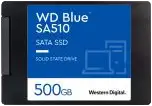
The Western Digital WD Blue SA510 is a SATA III solid-state drive aimed at the mainstream market. Launched on May 31, 2022, the SA510 occupies the mainstream segment of Western Digital’s SSD portfolio, positioned between the entry-level WD Green series and the performance-oriented WD Black series. It competes with other value-oriented SATA SSDs such as the Crucial MX500, and Kingston KC600. It also comes in two different form factors – 2.5″ and M.2 – but the specifications are otherwise identical.
Controller and Cache
Othan dual form factors, the WD Blue SA510 also comes with different controllers depending on capacity. Models up to 1TB are equipped with the proprietary SDC1 (A101-000125) “Milpitas” controller, a cost-effective DRAM-less design, whereas the 2TB model uses the Silicon Motion SM2259H controller, which includes DRAM cache support for improved performance consistency at higher capacities. Both controllers support the SATA III 6 Gbps interface and provide full compatibility with the Advanced Host Controller Interface (AHCI) standard.
NAND Flash Memory
Like many other SSDs from Western Digital and SanDisk, the SA510 employs 112-layer 3D TLC (Triple-Level Cell) BiCS5 NAND flash memory manufactured by Kioxia. This generation of NAND provides improved density and performance compared to earlier planar NAND designs, while maintaining competitive pricing. It’s important to note that Western Digital has shipped the SA510 with multiple NAND configurations over its production run, which may result in slight performance variations – even between units with the same capacity.
Power Consumption
As an entry-level SSD, the WD Blue SA510 offers low power and is therefore suitable for older, SATA-based laptops. The max active power consumption is 2W for the 256 GB and 512 GB capacities, and 3W for the larger capacities. It also features modern power management features including Device Sleep (DEVSLP) for ultra-low power states during system hibernation.
Technical Specifications
| Specification | 250GB | 500GB | 1TB | 2TB | 4TB |
|---|---|---|---|---|---|
| Model Number (2.5") | WDS250G3B0A | WDS500G3B0A | WDS100T3B0A | WDS200T3B0A | WDS400T3B0A |
| Model Number (M.2) | WDS250G3B0B | WDS500G3B0B | WDS100T3B0B | WDS200T3B0B | N/A |
| Interface | SATA III 6Gb/s | SATA III 6Gb/s | SATA III 6Gb/s | SATA III 6Gb/s | SATA III 6Gb/s |
| Form Factor | 2.5"/M.2 2280 | 2.5"/M.2 2280 | 2.5"/M.2 2280 | 2.5"/M.2 2280 | 2.5" only |
| Sequential Read (MB/s) | 555 | 560 | 560 | 560 | 560 |
| Sequential Write (MB/s) | 440 | 510 | 520 | 520 | 520 |
| Random Read IOPS (2.5") | 80,000 | 90,000 | 90,000 | 87,000 | 87,000 |
| Random Read IOPS (M.2) | 80,000 | 90,000 | 90,000 | 85,000 | N/A |
| Random Write (IOPS) | 78,000 | 82,000 | 82,000 | 83,000 | 83,000 |
| Endurance (TBW) | 100 | 200 | 400 | 500 | 600 |
| Average Active Power (mW) | 50 | 50 | 60 | 100 | 100 |
| Max Read Power (mW) | 1,800 | 1,800 | 1,800 | 3,000 | 3,000 |
| Max Write Power (mW) | 2,000 | 2,000 | 2,000 | 3,000 | 3,000 |
| Slumber Power (mW) | 36 | 36 | 36 | 70 | 70 |
| DEVSLP Power (mW) | 12 | 12 | 12 | 7 | 7 |
| MTTF (hours) | 2,250,000 | 2,250,000 | 2,250,000 | 2,250,000 | 2,250,000 |
| Operating Temperature | 0°C to 70°C | 0°C to 70°C | 0°C to 70°C | 0°C to 70°C | 0°C to 70°C |
| Non-Operating Temperature | -55°C to 85°C | -55°C to 85°C | -55°C to 85°C | -55°C to 85°C | -55°C to 85°C |
| Operating Vibration | 5.0 gRMS, 10-2000 Hz | 5.0 gRMS, 10-2000 Hz | 5.0 gRMS, 10-2000 Hz | 5.0 gRMS, 10-2000 Hz | 5.0 gRMS, 10-2000 Hz |
| Shock | 1,500G @ 0.5ms | 1,500G @ 0.5ms | 1,500G @ 0.5ms | 1,500G @ 0.5ms | 1,500G @ 0.5ms |
| Warranty (years) | 5 | 5 | 5 | 5 | 5 |
| Dimensions (2.5") | 100.2×69.85×7mm | 100.2×69.85×7mm | 100.2×69.85×7mm | 100.2×69.85×7mm | 100.2×69.85×7mm |
| Dimensions (M.2) | 80×22×2.38mm | 80×22×2.38mm | 80×22×2.38mm | 80×22×2.38mm | N/A |
| Weight (2.5") | 34.6g ±1g | 34.6g ±1g | 34.6g ±1g | 34.6g ±1g | 34.6g ±1g |
| Weight (M.2) | 4.8g ±1g | 4.8g ±1g | 4.8g ±1g | 6.4g ±1g | N/A |
WD Blue SA510 Product Brief (PDF) – Official Western Digital datasheet
The SA510 offers broad compatibility with legacy systems through its SATA III interface, which is backward compatible with SATA II and SATA I connections. Note, however, that the M.2 2280 SATA version is not compatible with modern PCIe/NVMe M.2.
Professional Reviews
N/A
Was this helpful?
1 / 0